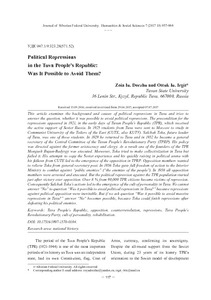Political Repressions in the Tuva People’s Republic: Was It Possible to Avoid Them?
Скачать файл:
URI (для ссылок/цитирований):
https://elib.sfu-kras.ru/handle/2311/33648Автор:
Dorzhu, Zoia Iu.
Irgit, Ottuk Iu.
Доржу, З.Ю.
Иргит, О.Ю.
Дата:
2017-07Журнал:
Журнал Сибирского федерального университета. Гуманитарные науки. Journal of Siberian Federal University. Humanities & Social Sciences;2017 10 (7)Аннотация:
This article examines the background and causes of political repressions in Tuva and tries to answer the question, whether it was possible to avoid political repressions. The precondition for the repressions appeared in 1921, in the early days of Tuvan People’s Republic (TPR), which received the active support of Soviet Russia. In 1925 students from Tuva were sent to Moscow to study in Communist University of the Toilers of the East (CUTE, also KUTV). Salchak Toka, future leader of Tuva, was one of those students. In 1929 he returned to Tuva and in 1932 he became a general secretary of the Central Committee of the Tuvan People’s Revolutionary Party (TPRP). His policy was directed against the former aristocracy and clergy. As a result one of the founders of the TPR Mongush Buyan-Badyrgy was executed. Moreover, Toka tried to make collectivization in Tuva but failed it. His attempts to copy the Soviet experience and his quickly raising in political arena with his fellows from CUTE led to the emergence of the opposition in TPRP. Opposition members wanted to relieve Toka from general secretary post. In 1936 Toka gave full freedom of action to the Interior Ministry to combat against “public enemies” (“the enemies of the people”). In 1938 all opposition members were arrested and executed. But the political repression against the TPR population started just after victory over opposition. Over 8 % from 90,000 TPR citizens became victims of repression. Consequently Salchak Toka’s actions led to the emergence of the cult of personality in Tuva. We cannot answer “No” to question “Was it possible to avoid political repressions in Tuva?” because repressions against political opposition were inevitable. But if we ask question “Was it possible to avoid massive repressions in Tuva?” answer “No” becomes possible, because Toka could finish repressions after defeating his political enemies Авторы статьи исследуют предпосылки и причины политических репрессий в период Тувин-
ской Народной Республики (1921-1944), пытаются выяснить, можно ли было избежать массо-
вых репрессий. Предпосылки для репрессий возникли ещё в 1921 г., когда Тувинскую Народную
Республику (ТНР) активно поддерживала Советская Россия. В 1925 г. первая группа студен-
тов-тувинцев была направлена в Москву для обучения в Коммунистическом университете
трудящихся Востока им. И.В. Сталина (КУТВ), среди которых был и будущий руководитель
ТНР, один из главных организаторов массовых политических репрессий С. Тока. Окончив КУТВ
в 1929 г., С.К. Тока вернулся в Туву и в 1932 г. стал генеральным секретарем Тувинской народ-
но-революционной партии. В 1929 г. все представители знати и духовенства были лишены
избирательного права, был казнен основатель партии Монгуш Буян-Бадыргы. С. Тока также
безуспешно проводил политику коллективизации. Его попытки продвинуть своих сокурсников
по КУТВ вызвали оппозиционные настроения в партии вплоть до попытки заговора с целью
сместить С. Тока с поста генсека. В 1936 г. С. Тока предоставил МВД Тувы полное право вести
борьбу с «врагами народа». В 1938 г. были арестованы и казнены все члены оппозиции, и нача-
лись репрессии против жителей ТНР. Пострадало 8 % из 90-тысячного населения. Действия
С. Тока привели к возникновению культа личности в ТНР. Мы не можем ответить отрица-
тельно на вопрос, возможно ли было избежать политических репрессий в ТНР, так как борьба
с оппозицией неизбежна. Но если сформулировать вопрос иначе: «Можно ли было избежать
массовых репрессий?», то вероятность ответа «Нет» становится больше, так как С. Тока
мог прекратить репрессии после расправы с непосредственными врагами
Коллекции:
Метаданные:
Показать полную информациюСвязанные материалы
Показаны похожие ресурсы по названию, автору или тематике.
-
Из истории основания и деятельности прокуратуры в Тувинской Народной Республике (1921–1944 гг.)
Доржу, З. Ю.; Шмит, И. Д.; Dorzhu, Zoia Iu.; Shmit, Irina D. (Сибирский федеральный университет. Siberian Federal University, 2021-08)Представлена история возникновения, становления и первоначальной деятельности органов прокуратуры в Тувинской Народной Республике (1921–1944). Данный процесс изучается во взаимосвязи с социально-политической ситуацией и ... -
Этнокультурная динамика коренных народов Енисейской Сибири в исследованиях 2010–2020-х гг.
Сертакова, Е. А.; Лещинская, Н. М.; Колесник, М. А.; Кистова, А. В.; Sertakova, Ekaterina A.; Leshchinskaya, Natalya M.; Kolesnik, Mariya A.; Kistova, Anastasiya V. (Сибирский федеральный университет. Siberian Federal University, 2021)В статье представлены результаты аналитической работы, в ходе которой были изучены исследования отечественных и зарубежных авторов, посвященные различным аспектам этнокультурной динамики коренных народов. Особое ... -
Decoration of Children’s Literature of the Indigenous Peoples of the North, Siberia and the Far East
Kolesnik, Mariia A.; Колесник, М.А. (Сибирский федеральный университет. Siberian Federal University., 2016-09)The article discusses the basic principles of decoration of children’s literature of the Indigenous Peoples of the North, Siberia and the Far East that are used by the artists-illustrators. The author carries out an analysis ... -
Scientific Modelling of Decorative and Applied Arts of the Indigenous Small-Numbered Peoples of the Krasnoyarsk Territory: Current State and Ways of Effective Development
Kolesnik, Maria A.; Sitnikova, Alexandra A.; Колесник, М.А.; Ситникова, А.А. (Сибирский федеральный университет. Siberian Federal University, 2017-10)The article presents a scientific model of the traditional functioning of the decorative and applied arts of the indigenous peoples of the Krasnoyarsk Territory (Krai). This is an “ecological model”, since it implies careful ... -
Gender-Based Approach to the Preparation of Young People of Tuva for Family Life
Seden, Aldynai V.; Седен, А.В. (Сибирский федеральный университет. Siberian Federal University., 2014-11)The marriage of the tuvinians was considered to be mandatory for every person, for extramarital relations were viewed with disapproval. Tuva families were large, differed stability, and divorces were rare due to the ...

